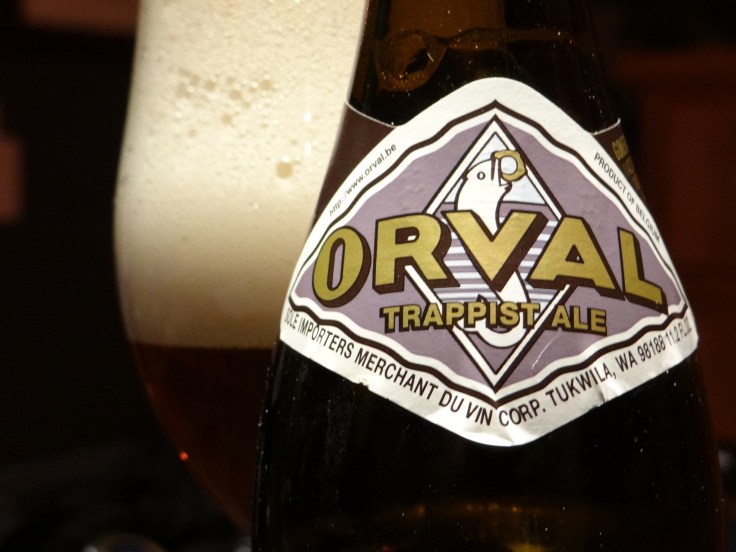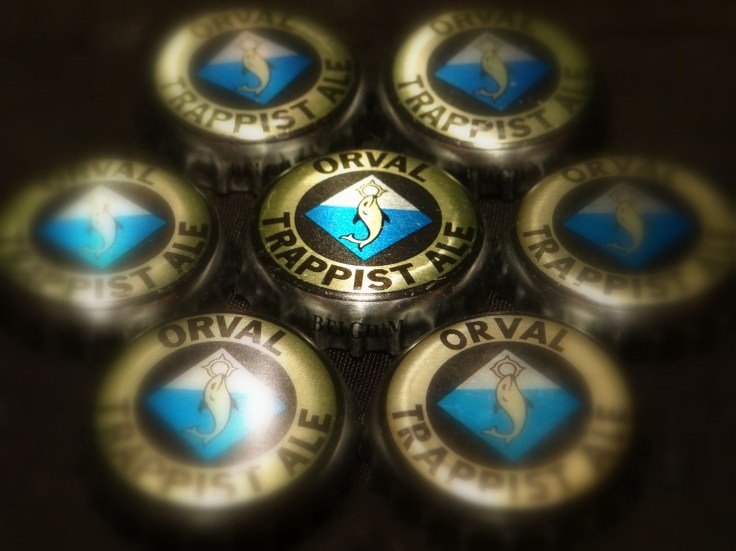If you follow the happenings of the beer world on social media, every once in a while you realize you’ve stumbled onto a beer holiday without even realizing it. I’m not talking St. Patrick’s Day or Thanksgiving weekend either. I’m talking about little known days like IPA Day (Aug. 7), Stout Day (Nov. 3), Sour Beer Day (Sept. 10), Lager Day (Dec. 10), and for those non-discerning beer lovers out there, Beer Can Appreciation Day (Jan. 24).* Fortunately forgetting one of these days doesn’t have the same consequences as overlooking your wedding anniversary or mother’s birthday. Beers don’t hold a grudge and who really needs an excuse to enjoy your favorite beer style? So as a general rule I don’t pay much attention to these made up holidays, but when I saw that this past Saturday (Mar. 26) was Orval Day I decided to make an exception. A beer so unique that it’s almost a style unto itself, Orval is permanently entrenched in my short list of the best beers in the world. The fact that it can readily be found in better beer stores throughout the industrialized world makes it even dearer to my heart. What better excuse to do a mini-vertical tasting of a beer that only gets better with age.
*Like Veterans Day or Easter the exact days change a little from year to year.

The Making of a Classic
The Trappists are monastic order of the Catholic church, whose motto is”pray and work”. Of the 20 Trappist monasteries in the world (19 in Europe, 1 in Massachusetts) ten brew beer to raise money to sustain the monastery with any excess profits going to charity. Each brewery is located within the walls of the monastery and overseen by the monks, although it is not unusual for they brewing operations to be left to secular brewers, as is the case for Orval. The Abbaye Notre-Dame d’Orval is located in the rolling forested hills of southern Belgium, a region known as the Ardennes. The name is play on the French term Val d’Or (valley of gold) purportedly given to the place by Countess Matilde in the 11th century. According to legend she dropped her wedding ring into a pool of water fed by a local spring. Understandably distraught she did what any 11th century Italian countess would do and started to pray for divine intervention. In answer to her prayers a trout rose to the surface of the water with the golden ring in his mouth. The bottle caps and labels bear the image of the legendary trout, and water from the spring is to this day used in the brewing process.

Unlike most Trappist breweries, Orval bottles only one type of beer, a style that is distinctly different from the high gravity, yeasty ales that are the hallmark of Trappist breweries like Chimay, Rochefort, and Westvleteren (a less potent version, Petite Orval, is available on draft at the brewery). To get a feel for the recipe I’ll quote directly from Jeff Alworth’s “The Beer Bible” (Workman Publishing, 2015):
“Orval uses two types of caramel malts, typical of English ales, but rare in Belgian ones. The brewery uses hard water and mashes at a low temperature, then adds a stiff dose of hops (Hallertauer, American hops, and Strisselpalt, which have come to replace the Styrian Golding) during the boil. At this point, it bears a strong resemblance to English pale ales, and that effect is enhanced by dry-hopping. But then Orval shifts gears. After a five-day fermentation, the beer goes to horizontal tanks where it is dosed with a second yeast infusion that includes Brettanomyces. … It spends three weeks in the horizontal tanks and another month in the bottle, ripening.”
The addition of Brett is what makes Orval such a shape shifter. Young Orval is something of a cross between an English pale ale and Belgian saision, but as it ages the hops fade, the beer becomes more dry, and the Brett funk comes to the fore. It’s the perfect beer for a vertical tasting.
Hunting Orval in the Wild
An impromptu vertical beer tasting is not an easy thing to pull off. To do it properly you need to plan out your purchases and be cellaring for years in advance. I did have one bottle of Orval that I squirreled away a couple of years ago, a check of the label revealed a bottling date of January 23, 2013 making it approximately 3 years and 2 months of age. But you can’t do a vertical tasting with one bottle, so at a minimum I needed to find the freshest bottle of Orval available in Columbus. From conversations with fellow Orval enthusiasts and what I’d read online about the best you can hope to do in the US is to score a bottle that is six months old. After all it is held in the brewery for a month, then makes the long journey across the Atlantic, and finally it must find its way to Columbus. On the other end of the spectrum I was hoping I might find a dusty neglected bottle with 4-5 years of age on it.
To aid in my search I reached out to people on the Columbus Craft Beer Consortium Facebook group. Several people suggested I try Market District in Grandview because they recently held a promotion where they broke the World Record for the most Orval sold in a day. Hence it seemed logical that they would have some fresh supply. However, despite going through their entire supply the best I could do was one with a bottling date of June 4, 2015, close to 10 months old. The freshest bottles at Weiland’s Market and Giant Eagle in Clintonville had the exact same bottling date. I suspect it would be difficult to find a fresher bottle anywhere in Columbus, but I’ll keep looking.
In terms of finding a bottle conveniently pre-aged by the retailer I couldn’t do any better than the 3 year old bottle I already had in my possession, but Giant Eagle did have a few bottles almost as old (bottled 2/7/2013). I picked one up to be better prepared for my next try at an Orval vertical, but there were still a few left in the back for those of you out there who want to try this experiment for yourself. I suspect if you are really diligent and look around you could find something a little older. I’d encourage anyone out there with tips on where to find the youngest and oldest bottles Orval to leave a comment.

Tasting Notes – Orval at 10 months of age
Even poured very carefully down the side of my tulip glass the beer pours with a massive head that fills three-fourths of the glass. The official Orval glass is a silver-rimmed, wide-mouthed goblet, which as I understand it is designed to accommodate Orval’s voluminous head. I don’t mind waiting a little longer in exchange for the superior odor trapping capabilities of a tulip glass. This approach is not for the impatient though. The head recedes very slowly, after 6-7 minutes about half of the original head remains with dense, meringue like chunks of foam clinging to the walls of the glass. It reminds me of the ice cream in a root beer float. The beer itself is golden amber and translucent.
The smell is yeasty with spicy phenols leading the way and fruity esters playing a supporting role. The nose is very much in the vein of a classic Belgian saison. The taste follows suit with spicy phenols, subtle hints of fruit (banana, lemon?), and a touch of caramel from the malts. The finish is dry and crisp with just a smidge of Brett funk. I’m not getting too much smell and flavor that I can clearly identify with the hops, but then again noble hops like Hallertauer tend to have a spicy note that blends well with the phenols from the yeast. The mouthfeel is effervescent, with prickly carbonation that tickles your tongue.
At this age I’d say Orval tastes a lot more like a saison than a pale ale. A damn good saison though. Referring back to the Beer Bible, Jeff Alworth calls Orval one of Belgium’s most traditional beers, one firmly rooted in the saison family. I will sheepishly admit that for a few years I confused the aroma and flavor characteristics of saison yeasts with those that come from Brett, based on my experience with bottles of Orval like this one.

Tasting Notes – Orval at 3 years of age
The formation of a billowing white head and its retention is similar to the 10 month old bottle. Visually it would be difficult to tell them apart. Changes are, however, evident in the nose. While there are still elements of a spicy saison, the Brett is more prominent here. The fruity notes have more pineapple character, and some leathery Brett funk has joined the party. The Brett character is even more apparent in the taste. The earthy, leathery, funky notes from the Brett have become one with the caramel undertones of the malt. Spicy phenols are still present, but now in a backing role. To my palate the taste is not terribly fruity, nor is it sour, but a more sensitive taster might get subtle hints of those flavors. There is no discernable hop flavor or aroma remaining. The mouthfeel is not quite as prickly and effervescent as the 1 year old variant, but the persistent Brett yeasts have done their job and the finish is if anything drier than the younger version.
The Brett is really hitting its stride in this bottle, but saison-like elements are still present making for a complex, distinctive beer in every sense of the word.
Closing Thoughts
I’m sure some of you have done Orval vertical tastings. I’d love to hear your experiences and tasting notes. I’ve read that in two year old bottles touches of diacetyl from incomplete Brett fermentation are sometimes present. What about bottles with four, five or more years on them?
Has all of this made you thirsty for some local Brett beers? Check back later this week when I post my long overdue reviews of Seventh Son’s Brett Beers, Winterborn and Feral, and share some highlights on the making of Brett only beers from my conversation with Colin Vent, head brewer at Seventh Son.
Three weeks today I’ll arrive in Belgium on my 30 year old Vespa scooter. Hoping for some fantastic beers (after the scooter has been put to bed!)
I’m sure you won’t be disappointed. Where do you plan to visit?
We’re doing a battlefield tour. First night is Waterloo, then Bastogne (battle of the bulge), then Nijmegen in Holland for “A Bridge Too Far”.
Nice! Very thorough article!!
>
Just a pedantic comment, but the bottling dates are in European format, so the 2015 bottle is June 4, not April 6. Otherwise, great post as always!
Of course you’re right. I realized they were using the European date format, but somehow my brain didn’t translate. Thanks for bringing it to my attention, I’m correcting the article right now.